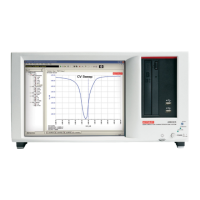3-138 Return to Section Topics 4200-900-01 Rev. K / February 2017
Section 3: Common Device Characterization Tests Model 4200-SCS User’s Manual
Running the ConPin-Pulse or ConPin-DC UTM (Switch projects only)
This test routes the desired pulse or SMU signals to the DUT by closing switches
on a switch matrix card. See Switch matrix connection to array DUT for
connection and switch matrix setup instructions. The UTM entries for TermIdStr1
to TermIdStr8 Pin1 to Pin8 define which instrument (SMU or VPU channel) get
connected to which output pin.
1. Enter a value for OpenAll. The default value is 1, which opens all switches. The remaining
parameters define which switches to close. If more than 8 closures are required for a test,
use two ConPin tests, setting the second ConPin test OpenAll = 0, to ensure the first
ConPin switch settings are not cleared. See Figure 3-110 for the screenshot of the ConPin
parameters.
2. Enter values for TermIdStr1 and Pin1. This first pair of parameters determines which
instrument, either SMU or VPU channel, gets output. For a SMU to be output on the 1
st
output of the switch matrix, TermIdStr1 = SMU1 and Pin1 = 1. If no connection is desired set
Pin1 = 0. Another way to set the connections is to use the GUI. To use the GUI, click the
GUI button (see Figure 3-110) that displays the dialog shown in Figure 3-111. Click the
desired crosspoint closures. The Input strings shown in the GUI must match the labels
supplied in the KCON setup for the switch matrix card (see Figure 3-99). Note that the Open
All checkbox (and OpenAll parameter in the UTM parameter list) controls whether to open
all switches before making any new switch closures. This checkbox does not clear the state
of the switches shown in Figure 3-111.
3. Continue to enter values for the remaining 7 pairs of TermIdStr and Pins.
4. Running the test will set the switch closures as specified.
There are three similar projects that stress the DUT with a number of
Program+Erase waveforms, then periodically measures the VT:
• FlashEndurance-NAND project
• FlashEndurance-NOR project
• FlashEndurance-switch project
The purpose of these projects is to determine the lifetime of the DUT, based on
the number of Program+Erase cycles withstood by the device before a certain
amount of shift, or degradation, in the VT or other measurement. The waveforms
may be unique for each pulse channel, and are defined in the separate Kpulse
program and saved to files. For more information refer to How to Generate Basic
Pulses and Using Kpulse to create and export Segment ARB waveforms.
These files are specified for each pulse channel in the test. The number and
interval for the pulse stresses are set, as well as the desired SMU measurements.
The typical measurement is a VT extraction based on a V
G
-I
D
sweep, but any type
of DC test may be configured.
These projects support from one to eight pulse channels to support typical 4-
terminal devices, as well as higher pin count devices or array test structures. The
8-terminal testing requires four Model 4205-PG2 cards and, for most tests, a
compatible external switch matrix.
The difference between the FlashEndurance-NAND and FlashEndurance-NOR
are the difference in the typical pulse widths and levels specific to the DUT type.
The FlashEndurance-Switch project is a generic example of the Flash testing

